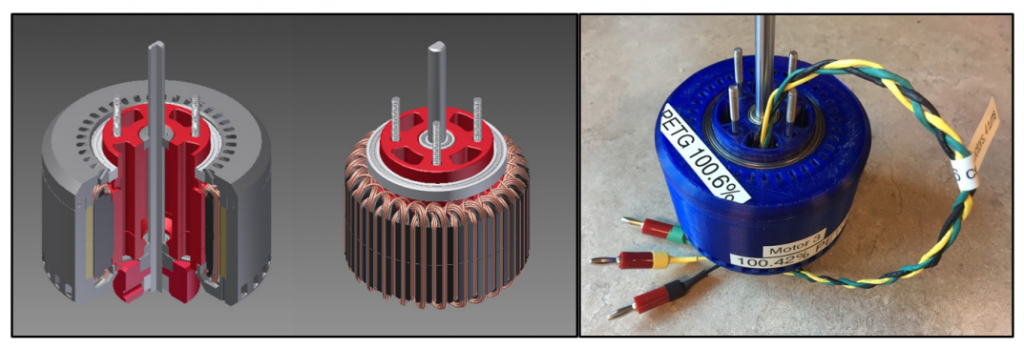In ‘3D Printed Motor: In-House Seedling Effort: Experiential Training for Building and Experimentally Testing a Motor Using 3D Printed Elements,’ authors Kevin J. Yost and Maxwell Stelmack discuss what they learned in a two-month technical sprint with the Air Force Research Laboratory (AFRL), meant to teach 3D printing skills and present challenges that would allow them to go on to fabricate more complex items like motors—and more specifically the creating of, experimenting with, and testing of a Halbach array permanent magnet motor.
This military-funded project involved ‘high performing’ undergraduate students looking toward careers in science and engineering, assisted by mentors from the Wright Brothers Institute (WBI) under an AFRL partnership intermediary agreement (PIA)—offering strong support. Design and 3D printing methods were offered by makeSEA, allowing the authors great latitude in reaching their project goals, while only working part time. The project team also purchased CAD motor design files from makeSEA, but they required unexpected refinements including several ‘trials and tribulations and slight design changes’ that led to some substantial delays and complications eventually overcome.
Other challenges and lessons within the project over eight weeks included experiential training and pioneering in a new area, along with the following exercises:
- 3D printing motor parts
- Assembling machinery
- Handling magnetic characterization of iron (Fe) filled prints
- Designing and experimenting with a range of configurations and attributes
- Developing a test bed for new material and design evaluation
“Designing and fabricating electric machines utilizing traditional electric machine methods is not simple. This is especially true when there is not a current role in AFRL to be a component supplier nor a specific project need which AFRL fills,” state the authors. “3D printing enables a quick and low-cost tool for AFRL to affordably build and assemble a motor. The project pioneers a new area for AFRL, not because AFRL will build the machines, but more to create technical acumen and readiness for evaluating and influencing external partners and their concepts.”
Two magnets had to be created to complete assembly of the rotor, and project participants were left to figure out the proper distribution of magnet weight/mass and magnet field strength:
“For measuring the weight and mass of the permanent magnets, careful attention is needed to ensure the magnetic field does not interfere with the measurement system and that the magnet is in the same position for each measurement,” stated the authors.
They also had to configure a 3D printed jig around the hall effect sensor, wire and configure the armature conductor, windings, complex testing of filaments, and in the end, simulation and testing of components. Challenges did continue as they discovered iron fill print was not viable for required conductivity, ‘intuition’ failed in some areas, and the electromagnetic FEA setup needs to be more comprehensive.
“This project represented a mini seedling effort for ‘getting in the game’ of AM,” concluded the researchers. “Many lessons and hidden costs were learned at low cost prior to committing to larger projects. It is recommended to further this effort with a follow on seedling research effort to continue increasing readiness for electric machine innovation.”
“Areas recommended include (1) rapid prototyping, (2) AM of more relevant multifunctional materials employed, and (3) developing a test-bed for advanced materials in electric machines. The follow on effort should be sufficiently resourced to close the loop between design configurations and design of experiments, hardware testing results, and FEA.”
The Air Force is not the only division of the U.S. Armed Forces delving into 3D printing, and training soldiers in new techniques for fabrication of parts that can be used in remote areas for repair and maintenance and transfer of supplies. Many other divisions of the military are exploring further uses of this progressive technology, from underway replenishment for the Navy to Army soldiers 3D printing in the field, Marines producing replacement parts, and more. Find out more about how the U.S. Air Force is using 3D printing currently here. What do you think of this news? Let us know your thoughts; join the discussion of this and other 3D printing topics at 3DPrintBoard.com.
[Source / Images: 3D Printed Motor: In-House Seedling Effort: Experiential Training for Building and Experimentally Testing a Motor Using 3D Printed Elements]Subscribe to Our Email Newsletter
Stay up-to-date on all the latest news from the 3D printing industry and receive information and offers from third party vendors.
You May Also Like
Precision at the Microscale: UK Researchers Advance Medical Devices with BMF’s 3D Printing Tech
University of Nottingham researchers are using Boston Micro Fabrication‘s (BMF) 3D printing technology to develop medical devices that improve compatibility with human tissue. Funded by a UK grant, this project...
3D Printing Webinar and Event Roundup: April 21, 2024
It’s another busy week of webinars and events, starting with Hannover Messe in Germany and continuing with Metalcasting Congress, Chinaplas, TechBlick’s Innovation Festival, and more. Stratasys continues its advanced training...
3D Printing Webinar and Event Roundup: March 17, 2024
It’s another busy week of webinars and events, including SALMED 2024 and AM Forum in Berlin. Stratasys continues its in-person training and is offering two webinars, ASTM is holding a...
3D Printed Micro Antenna is 15% Smaller and 6X Lighter
Horizon Microtechnologies has achieved success in creating a high-frequency D-Band horn antenna through micro 3D printing. However, this achievement did not rely solely on 3D printing; it involved a combination...

































